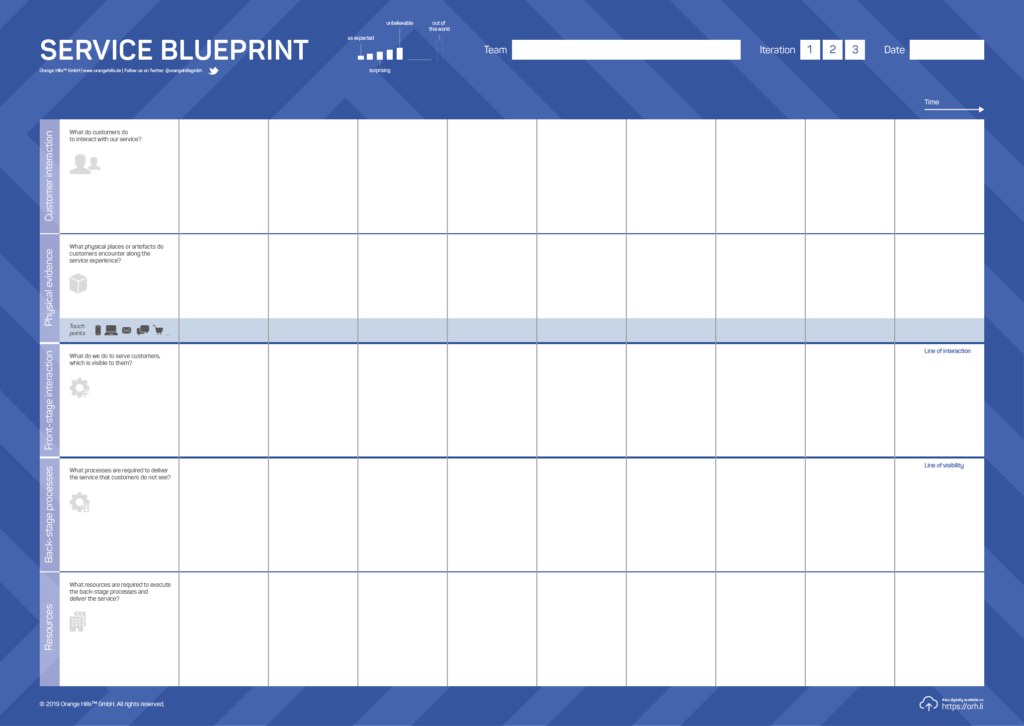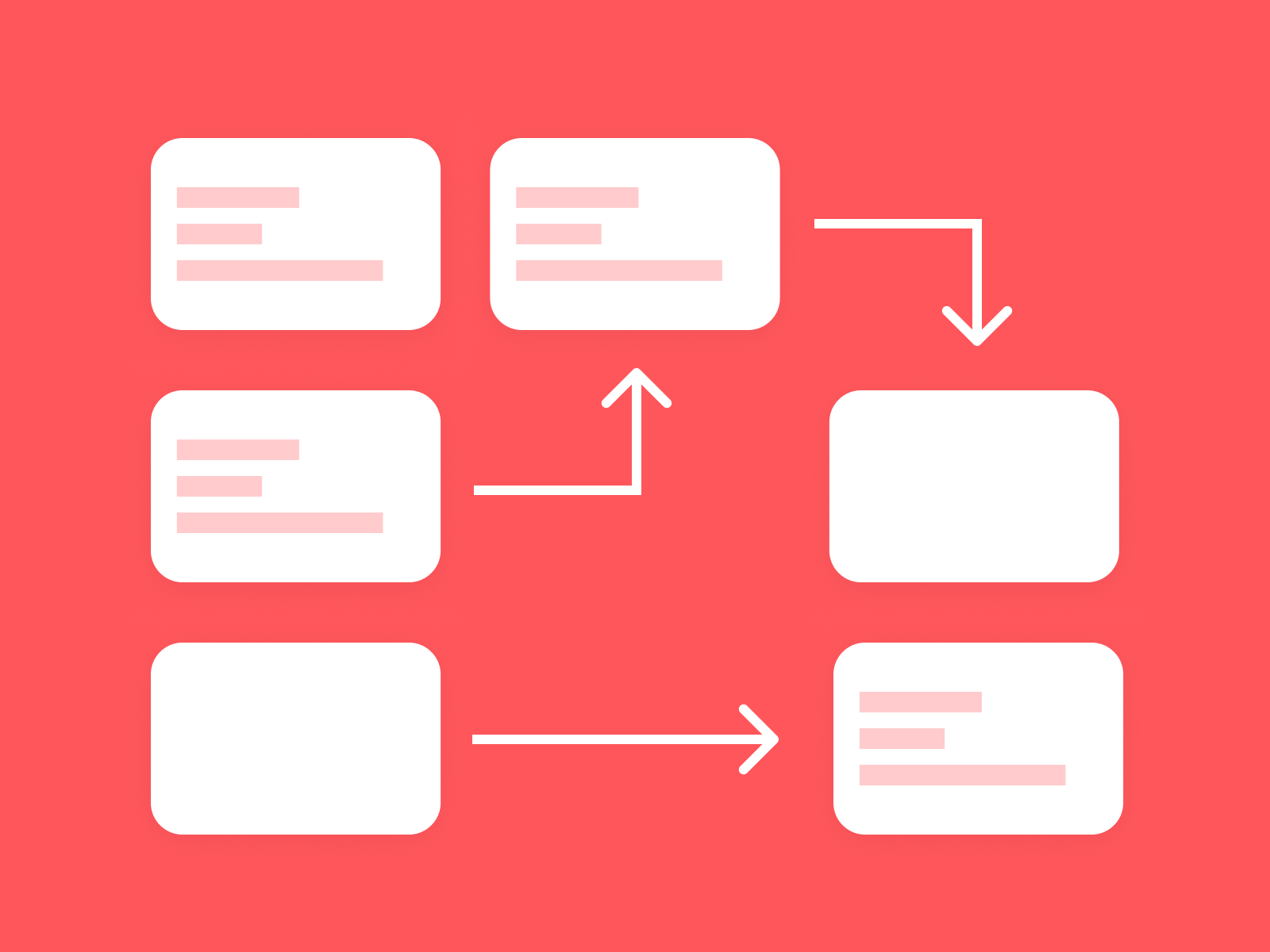Service blueprints are an essential tool for any service-oriented organization. They provide a detailed map of all the touch points between a company and its customers and can be used to improve service quality and design new services.
In this complete guide, we’ll cover everything you need to know about service blueprints, including how to create them and what they can be used for.
We’ll also share some examples of service blueprints in action so you can see how they can be applied in real-world scenarios.
So, whether you’re looking to improve your existing services or design brand-new ones, read on to find out everything you need to know about service blueprints.
Table of Contents
What Is A Service Blueprint?
A service blueprint is a graphical representation of all the touchpoints between a company and its customers.
It maps out every step of the customer journey, from initial contact through to post-purchase follow-up, and shows how different channels (e.g., online, in-store, call center) interact with each other.
Service blueprints can be used to improve existing services or design new ones from scratch. They’re an essential tool for any organization that wants to deliver an outstanding customer experience.


How To Create A Service Blueprint
When creating a service blueprint, there are five key steps you need to take:
1. Define the scope of the service
The first step is to define the scope of the service. This includes identifying the customers who will use the service, as well as the specific touch points where they will interact with it.
It’s important to be as specific as possible when defining the scope, as this will make it easier to create an accurate blueprint.
2. Identify all touchpoints
The next step is to identify all of the touch points where customers will interact with the service. This includes both physical and digital touchpoints, such as call centers, websites, and retail stores. Once you’ve identified all of the touch points, you need to map out how they are interconnected.
3. Analyze customer journeys
The third step is to analyze the customer journeys through the service. This involves mapping out how customers move from one touch point to another, as well as how they interact with each touch point. By analyzing the customer journey, you can identify areas where service quality can be improved.
4. Identify pain points
The fourth step is to identify any pain points that customers may experience during their journey. Pain points are areas where customer satisfaction is low, and a number of factors can cause them. Once you’ve identified the pain points, you need to find ways to eliminate them.
5. Create a service blueprint
The final step is to create a service blueprint. This is a visual representation of the customer journey, which includes all of the touch points and pain points.
The blueprint should be easy to understand and should be used as a tool to improve the quality of the service.
By following these steps, you can create a service blueprint that will help you improve the quality of your service and increase customer satisfaction.
What Are The Benefits Of Using A Service Blueprint?
Service blueprints offer a number of benefits, including:
Improved service quality: By mapping out the customer journey in detail, service blueprints can help you identify areas where service quality can be improved.
For example, you may find that customers are frequently getting frustrated at a particular touch point, such as when they’re trying to buy something online.
By improving the customer experience at key touchpoints, you can deliver a better overall service.
Increased customer satisfaction: Happy customers are more likely to come back and do business with you again.
By using a service blueprint to improve the customer experience, you can increase customer satisfaction and loyalty.
Happy customers are more likely to come back and do business with you again. By using a service blueprint to improve the customer experience, you can increase customer satisfaction and loyalty.
Reduced costs: By identifying inefficiencies in the customer journey, service blueprints can help you find ways to reduce costs.
For example, you may find that a particular process is taking longer than it should, or that customers are having to contact multiple channels (e.g., call center and website) to get the information they need.
By improving the efficiency of your processes and reducing the number of touchpoints, you can save time and money.
Improved competitive advantage: In today’s competitive marketplace, businesses need to do everything they can to stand out from the crowd.
You can gain a competitive advantage over your rivals by using a service blueprint to improve the customer experience.
Reduced risk: When launching a new product or service, there’s always a risk that it won’t meet customer expectations.
By using a service blueprint to map out the customer journey in detail, you can identify potential problems before they occur. This helps to reduce the risk of launches and ensure that your products and services are successful.
What Are The Drawbacks Of Using A Service Blueprint?
While service blueprints offer a number of benefits, there are also some potential drawbacks to using them, including:
They can be time-consuming and complex: Service blueprints can be very detailed and complex documents. They can take a long time to create, especially if you have a large and complicated service.
They may require specialist knowledge: Service blueprints can be technical documents, and they may require specialist knowledge to create and interpret them. This can make them challenging to understand for people who are not familiar with the concept.
They can be expensive to create: Creating a service blueprint can be a costly exercise, especially if you need to hire specialists to help you.
When To Make A Service Blueprint
Not all services need a blueprint. In fact, most don’t. So when should you make one?
Here are some guidelines:
1. When you’re starting from scratch
If you’re starting from scratch with a new service, it’s a good idea to create a service blueprint. This will help you map out the customer journey and identify potential problems and opportunities.
2. When you’re making major changes to an existing service
If you’re making major changes to an existing service, such as adding a new step to the customer journey, it’s a good idea to create a service blueprint. This will help you map out the new customer journey and identify potential problems and opportunities.
3. When you’re having difficulty delivering a service
If you’re having difficulty delivering a service, such as high levels of customer complaints or missed targets, it may be helpful to create a service blueprint. This will help you identify the root cause of the problem and develop solutions.
4. When you want to improve an existing service
If you want to improve an existing service, such as increasing customer satisfaction or reducing costs, it may be helpful to create a service blueprint. This will help you identify potential improvements and develop solutions.
5. When you’re developing a new service
If you’re developing a new service, it’s a good idea to create a service blueprint. This will help you map out the customer journey and identify potential problems and opportunities.
Creating a service blueprint can be a helpful way to improve your service delivery. However, it’s important to remember that not all services need a blueprint. In most cases, it’s best to focus on delivering a great service without one.
Things To Keep In Mind When Creating A Service Blueprint
When creating a service blueprint, there are several important factors to keep in mind in order to create a successful and effective design. Here are some key considerations:
1. Define the problem or opportunity that the service is meant to address. What need does it fill? What gap does it bridge? What problem does it solve? Answering these questions will help you define the purpose of the service and ensure that it is meeting a real need.
2. Research your target audience. Who will be using this service? What are their needs and expectations? Understanding your audience will help you tailor the service to meet their specific needs.
3. Develop a clear value proposition. Why should people use this service? What benefit will they derive from it? Answering these questions will help you articulate the unique value of your service.
4. Create a user-friendly interface. The interface should be intuitive and easy to use. It should be designed with the user in mind, and all features should be accessible and straightforward.
5. Make sure the service is reliable. People should be able to rely on the service to meet their needs consistently. This means ensuring that the service is available when needed and that it performs as expected every time.
6. Test and iterate. It’s important to test the service before making it available to the public. This will help you identify any potential issues and make necessary adjustments. Once the service is launched, continue to monitor it and make improvements as needed.
By keeping these factors in mind, you can create a service blueprint that will be successful and effective. With a well-designed service, you can make a real difference in the lives of those who use it.


Conclusion
Service blueprints are a great way to document and improve your customer service. They can help you identify areas for improvement, and make sure that all of your employees are providing the same level of service.
By creating a service blueprint, you can also ensure that your customers have a positive experience every time they interact with your company.
Keep in mind though that there may be some drawbacks to using this tool, so it’s important to weigh the pros and cons before making a decision.




